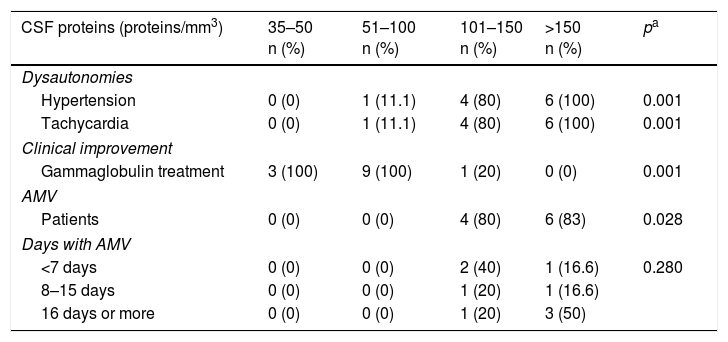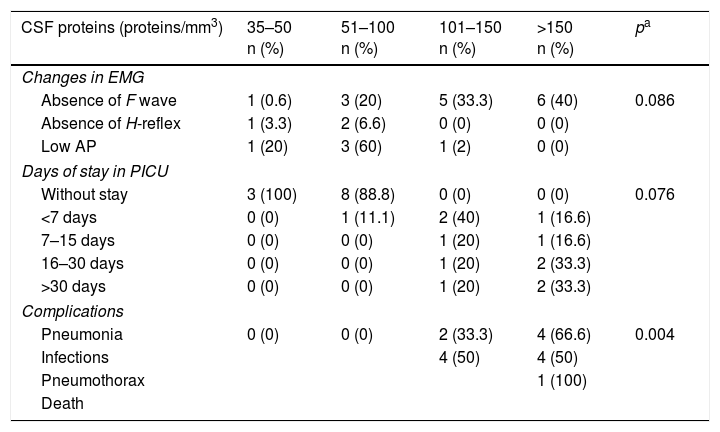The albumin-cytologic dissociation in cerebrospinal fluid (CSF) supports the diagnosis of Guillain–Barre syndrome (GBS) but does not support the prognosis, so the aim of this study is to determine the usefulness of protein numbers in the CSF to predict progression in pediatric patients.
Patients and methodsA diagnostic test was performed in pediatric patients with GBS, analysing sociodemographic, clinical and protein variables in CSF as well as electromyography. The presence of dysautonomia was also documented.
ResultsData were analyzed from 23 patients, predominantly males (87%), school age (43.5%) and history of digestive infection (73.9%). Using the ROC curve, an area under the curve of 0.966 with best CSF protein cut-off point of 87–92proteins/mm was found for the presence of dysautonomias and to evaluate the poor response to treatment with 0.969 intravenous immunoglobulin with better cut-off point in 157proteins/mm.
ConclusionThe amount of proteins in the CSF can be used as a prognostic indicator and severity, such that proteins greater than 100 in CSF translate into a torpid evolution and with greater complications.
La disociación albuminocitológica en el líquido cefalorraquídeo (LCR) apoya el diagnóstico de síndrome de Guillain-Barré (SGB) pero no ayuda en el pronóstico, por lo que el objetivo de este estudio es determinar la utilidad de las cifras de proteínas en el LCR para predecir la evolución en pacientes pediátricos.
Pacientes y métodosSe realizó un estudio de prueba diagnóstica, en pacientes pediátricos con SGB, analizando variables sociodemográficas, clínicas y proteínas en LCR, así como electromiografía; también se documentó la presencia de disautonomías.
ResultadosSe analizaron datos de 23 pacientes, predominando el sexo masculino (87%), la edad escolar (43,5%) y el antecedente de infección digestiva (73,9%). Mediante la curva COR se encontró, para la presencia de disautonomías, un área bajo la curva de 0,966 con mejor punto de corte de proteínas en LCR de 87-92 proteínas/mm, y para evaluar la pobre respuesta al tratamiento con inmunoglobulina intravenosa, de 0,969, con mejor punto de corte en 157 proteínas/mm.
ConclusiónLa cantidad de proteínas en el LCR puede utilizarse como un indicador pronóstico y de gravedad, de tal manera que unas proteínas mayores de 100 en el LCR se traducen en una evolución tórpida y con mayores complicaciones.












